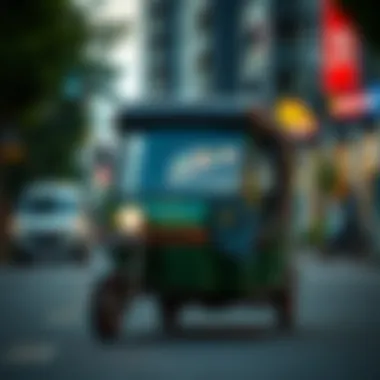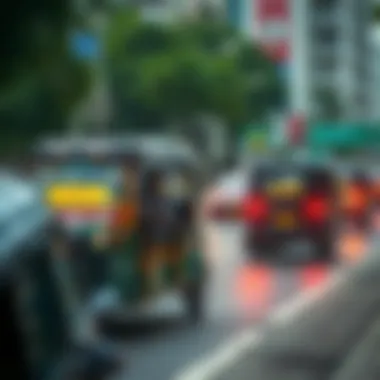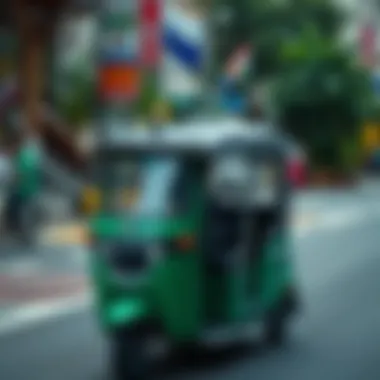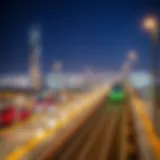Tuk Tuks: Pioneering Sustainable Urban Transport


Intro
Tuk tuks are more than just colorful three-wheeled vehicles zipping through bustling city streets; they represent a pivotal shift toward sustainable urban mobility. As urbanization accelerates, cities like Dubai grapple with increasing congestion and pollution. This is where tuk tuks can come into play, offering a solution that not only eases transportation woes but also promotes an eco-friendly environment.
The integration of tuk tuks within existing transport frameworks characterizes a forward-looking approach to urban planning. Unlike traditional vehicles that guzzle fuel and contribute heavily to carbon emissions, tuk tuks, often powered by cleaner fuels or electric systems, present a greener alternative. This article aims to explore how their adoption can reshape urban landscapes, facilitating not just mobility, but also economic growth and social inclusivity.
Market Trends and Analysis
Current Market Conditions
The global transportation industry is undergoing significant transformation. In the Middle East, particularly in cities like Dubai, the increasing demand for sustainable transport solutions is echoing in emerging market trends. With greater awareness of environmental issues, more people are leaning towards lower-emission vehicles. Tuk tuks fit the bill, offering nimble and efficient transit options.
- Popularity Surge: The use of tuk tuks has ramped up in urban centers where traffic congestion and pollution levels reach alarming heights.
- Policy Support: Governments are pushing for sustainable mobility options, incentivizing alternative transport methods through subsidies and regulatory frameworks.
- Urban Infrastructure Adaptation: Cities may adapt their infrastructure to accommodate these vehicles, creating dedicated lanes and charging stations, which underscores their growing significance.
Future Predictions and Growth Areas
As we peer into the future, several trends are shaping the tuk tuk market and its place in urban mobility.
- Technological Advancements: Expect innovations in electric tuk tuks and battery technology, enhancing their appeal.
- Rise of Shared Mobility: The trend towards shared transportation could see tuk tuk services being incorporated into ride-hailing platforms, allowing for more people to utilize them efficiently.
- Tourism Integration: Many tourists prefer unique local experiences; tuk tuks can become emblematic of urban tours, blending local culture with sustainable travel.
"For cities striving to achieve sustainability, the adoption of tuk tuks can be a game changer, bridging the gap between convenience and environmental consciousness."
Prolusion to Sustainable Cities
The rapid growth of urban centers has become a defining feature of modern society, bringing along various challenges, from congestion to pollution. Sustainable cities aim to counter these issues by integrating systems that not only address daily transport needs but also prioritize the health of the environment and the wellbeing of their inhabitants. The exploration of sustainable urban landscapes considers an array of interrelated aspects such as ecological footprints, community engagement, and innovative transport solutions, which will play a central role throughout this article.
In this context, tuk tuks emerge as a particularly promising mode of transportation. Their compact form, economic viability, and adaptability to varied urban environments make them well-suited for promoting sustainable practices.
"As urban areas contend with the pressing issues of climate change and overpopulation, the need for adaptive transportation solutions is more crucial than ever."
Expounding on the integration of tuk tuks in sustainable cities reveals multiple benefits:
- Reduced Traffic Congestion: Their small size allows for easier navigation through crowded streets, which can alleviate some of the traffic woes faced by larger vehicles.
- Lower Emissions: Many tuk tuks are designed to run on cleaner energy sources, significantly decreasing the carbon output compared to traditional cars.
- Community Enhancement: As a culturally relevant form of transportation in many regions, tuk tuks strengthen ties within neighborhoods by supporting local economies.
The role of eco-friendly transportation within sustainable urban planning is not merely about finding the most efficient modes of transportation but also about fostering a society that values and invests in sustainable practices. This creates a ripple effect, influencing everything from how urban spaces are developed to how residents choose to commute.
Engaging with these ideas thoroughly sets the stage for a deeper understanding of how tuk tuks can function as more than just a means of transport—they can be a linchpin in the broader context of sustainable urban development, steering cities towards more holistic, eco-conscious growth.
Tuk Tuks: An Overview
Tuk tuks, those three-wheeled vehicles found weaving through the streets of buzzing metropolises, play a pivotal role in our pursuit of sustainable urban environments. Understanding their significance involves delving into their origins, evolution, and current applications in urban transport systems. This exploration reveals not only their utility as a transportation method but also the myriad ways they contribute to economic, social, and environmental sustainability.
Origins and Evolution of Tuk Tuks
Tuk tuks trace their roots back to the early 20th century, originating in Thailand as a simplified version of the motorbike. They gained popularity quickly due to their nimbleness in congested streets. The design morphed through the years, as various regions adopted and adapted them to fit local needs. In India, for instance, they became the ubiquitous auto rickshaw, often painted in vibrant colors and adorned with local symbols. Their compact size allows them to navigate narrow lanes, making them invaluable in densely populated areas.
During the 2000s, the tuk tuk began to evolve again, driven this time by technology and the push for eco-friendly transportation. Electric tuk tuks started hitting the roads, providing a cleaner alternative without the usual fumes belching from their conventional counterparts.
"The evolution of tuk tuks from simple motorized rickshaws to modern electric vehicles represents a significant step toward greener urban transport options."
Such advancements not only cater to environmental concerns but also resonate with a growing population that is becoming increasingly conscious about their carbon footprint.
Current Usage in Urban Environments
Today, tuk tuks are prevalent in cities around the world, from the sandy streets of Dubai to the bustling alleys of Bangkok. Their unique footprint enables them to ease urban congestion significantly. In cities where cars dominate, tuk tuks present an alternative that does not require expansive infrastructure. They can operate effectively without the need for wide roads or complex transit systems.


In Dubai, for example, the integration of tuk tuks into the public transport network offers an accessible option for both residents and tourists. They serve not only as a transport solution but also as a tool for local businesses, especially in high-tourist areas. Moreover, the affordability of tuk tuks makes them appealing to various socioeconomic groups, thereby enhancing mobility for all residents.
As cities look to enhance their urban landscapes sustainably, tuk tuks emerge as a versatile transport medium that meets a range of needs. Not only do they help reduce travel times in congested areas, but they also contribute to economic growth by connecting communities and services that might otherwise remain isolated.
In summary, the evolution and current use of tuk tuks present a compelling case for their role in fostering sustainable urban landscapes. The shift from traditional combustion engines to electric-powered models reflects a broader trend toward sustainability in urban mobility solutions.
Environmental Impact of Tuk Tuks
The role that tuk tuks play within urban environments extends far beyond just being a novel mode of transport. In the context of sustainable cities, their environmental impact is an essential aspect to consider. Tuk tuks can offer significant advantages in reducing urban pollution, improving air quality, and easing traffic congestion. As cities grapple with challenges like climate change, incorporating eco-friendly transportation solutions like tuk tuks could be a game changer for urban landscape management.
Carbon Footprint Comparison
When we discuss the carbon footprint, it's imperative to compare the emissions from tuk tuks against more traditional vehicles like cars and buses. On average, a tuk tuk emits significantly less carbon dioxide per passenger-mile than a conventional car. For example, studies show that tuk tuks can emit about 35% less CO2 compared to standard sedans on urban routes, which can often get stuck in traffic and thus burn more fuel.
Also, when you take into account the average distance that commuters travel in cities, tuk tuks can be a more efficient choice, effectively combining lower emissions with quicker transport times. This efficiency not only helps in cutting down the overall carbon output but also paves the way for cities striving to meet their environmental targets.
"Tuk tuks could represent a significant reduction in a city's overall carbon emissions, making them a linchpin in the fight against urban pollution."
Energy Efficiency and Fuel Consumption
Energy efficiency is another feather in the tuk tuk's cap. These vehicles are designed to be lightweight and compact, which naturally leads to lower fuel consumption. A typical tuk tuk consumes around fuel equivalent of 50 miles per gallon, effectively far surpassing the average fuel efficiency of passenger vehicles. This means fewer trips to the gas station and less burden on local economies relying on imported fuel.
Moreover, many tuk tuks are now being designed to utilize alternative fuels like electricity or compressed natural gas, which further enhances their sustainability. The adoption of electric tuk tuks could make them virtually zero-emissions at the point of use. As urban planners consider the future landscape of cities, the significance of integrating such vehicles into transport networks becomes clear—reducing reliance on fossil fuels is not just smart; it's essential.
In summary, the environmental impact of tuk tuks is a multi-faceted subject. Through their lower carbon emissions and energy efficiency, these vehicles can significantly contribute to more sustainable urban mobility, making cities greener and more livable overall.
Economic Advantages of Incorporating Tuk Tuks
The economic advantages of incorporating tuk tuks into urban landscapes is a significant aspect that caters to both individual commuters and the broader community. As urban areas face challenges like congestion and pollution, these vehicles present a financially attractive solution. Moreover, they have the potential to augment local economies in pivotal ways.
Cost-Effectiveness for Commuters
When it comes to affordability, tuk tuks are a noteworthy contender in urban transportation choices. For everyday commuters—be it students heading to school or professionals getting to work—these vehicles can offer a cost-effective means of travel. The fare structures for tuk tuks are often lower than those for traditional taxis or rideshare services. This is especially crucial in cities where every dirham counts.
- Lower Fares: A typical ride in a tuk tuk might cost significantly less than a taxi, which can charge a premium for starting fares and long distances. This makes tuk tuks accessible for a larger group of people, particularly those within lower income brackets.
- Shared Rides: Many tuk tuks operate under a semi-shared model, allowing passengers to split fares. This practice not only reduces costs but also enhances social interaction among commuters. It's where you might meet a neighbor you never knew you had.
Moreover, the efficiency of tuk tuks can lead to savings in time too. In congested urban areas, their compact size allows for better maneuverability, meaning that passengers can often reach their destinations faster.
Job Creation within the Local Economy
In terms of economic impact, the job creation potential associated with tuk tuks significantly enhances their importance in urban transportation systems. These vehicles can act as a catalyst for boosting local employment rates. Let's dive deeper into how tuk tuks contribute to this.
- Driver Employment: Every tuk tuk on the road represents a job opportunity. Drivers often come from local communities, meaning that the earnings stay within the area. This steady flow of income helps to support families, fostering community resilience.
- Maintenance and Repairs: The presence of tuk tuks can stimulate jobs related to maintenance and repairs. Local mechanics can thrive as the demand for upkeep increases. This not only enriches the local economy further but also builds skill sets that can be valuable in other sectors.
- Local Business Support: Tuk tuk drivers commonly serve specific neighborhoods, which can lead passengers to local businesses they might otherwise overlook. From small cafes to emerging marketplaces, the transport model has the potential to drive increased footfall and sales for entrepreneurs trying to make a name in the community.
By incorporating tuk tuks as a transportation option, cities can create an ecosystem that not only meets mobility needs but also stimulates local economies and promotes sustainable urban living.
In summary, the economic advantages of tuk tuks go beyond just providing an affordable ride. They create a framework where cost-effectiveness thrives while simultaneously bolstering local markets and employment. As cities explore options for sustainable urban mobility, the economic case for tuk tuks becomes increasingly compelling.
For more insights on sustainable urban planning, visit Wikipedia on Sustainable Cities or explore related discussions on platforms like Reddit.
In a world where balancing the economy with sustainability is crucial, tuk tuks are more than a trend; they're an integral part of the urban solution.
Social Implications of Tuk Tuks in Urban Areas
The role of tuk tuks in our cities goes far beyond mere transportation. By weaving into the fabric of urban life, they become significant players in shaping social landscapes. Their compact form offers flexibility and accessibility that larger vehicles cannot match, making them particularly suited for dense urban areas. In this section, we will explore how tuk tuks enhance mobility for all socioeconomic groups and foster better community connections, thus demonstrating their profound social implications.


Enhancing Mobility for All Socioeconomic Groups
Tuk tuks have a unique ability to bridge the gap between luxury transportation and budget options. Unlike traditional taxis that might charge higher fares, tuk tuks offer a more affordable and approachable alternative. This aspect is particularly crucial in cities like Dubai, where a significant portion of residents may be working in lower-paying jobs. Tuk tuks allow these individuals to commute without breaking the bank.
- Cost-Effective: On average, tuk tuk rides are cheaper, making them accessible to a diverse demographic, from workers to tourists.
- First and Last Mile Solutions: They serve as vital connectors, helping people reach transit hubs or their final destinations from public transport nodes, like Metro stations, especially in areas lacking proper bus service.
- Inclusive Design: Many tuk tuks are designed to accommodate passengers with disabilities, providing greater freedom of movement for everyone in the community.
One can clearly see how the integration of tuk tuks into urban transport networks makes mobility more equitable. By offering a means for everyone to travel, tuk tuks help cultivate a city where all residents, regardless of their economic status, can navigate freely.
Fostering Community Connections
Tuk tuks do more than transport people; they are mobile social hubs. As these vibrant vehicles zip through city streets, they create opportunities for interaction among passengers and drivers alike. This spontaneous engagement encourages a sense of belonging within the urban setting.
- Local Culture Representation: Drivers often share stories and local knowledge with their passengers, enriching their experience and deepening the cultural fabric of the area.
- Supporting Local Businesses: Tuk tuk services can directly or indirectly promote local shops and eateries, as many drivers form informal partnerships with these establishments, taking customers to hotspots.
- Community Events and Initiatives: In some areas, tuk tuks are utilized for community projects or events, acting as shuttles that not only facilitate transport but also bring people together.
"The essence of a city lies in its ability to connect its people, and tuk tuks are at the heart of that connection."
Case Studies of Tuk Tuk Integration
Examining real-world examples of tuk tuk integration provides valuable insights into their role in urban mobility. Understanding these case studies highlights both the successful applications and the challenges faced by cities around the globe. Through these narratives, stakeholders can better evaluate the adaptability of tuk tuks to local contexts, and enrich discussions on sustainable transportation strategies.
Successful Implementations in Global Cities
Cities like Bangkok, Thailand and Pune, India serve as exemplary case studies for successful tuk tuk implementations. In Bangkok, tuk tuks are not just another mode of transport; they have woven themselves into the very fabric of the city’s circulation system. The government recognized their potential to alleviate traffic congestion and launched initiatives, including designated lanes and clear regulatory frameworks, to support their operation. Here, tuk tuks not only decreased the traffic flow on the streets but also provided commuters with a unique way to navigate the city’s bustling atmosphere.
In Pune, the introduction of electric tuk tuks has been a noteworthy advancement. This move significantly lowered emissions, aligning with the city’s goal of reducing its environmental footprint. Local authorities set out incentives for electric vehicle adoption, creating a smoother transition towards cleaner transportation modes. As a result, the sense of community among drivers improved, and passenger satisfaction increased due to quieter, more pleasant rides.
Moreover, in Dhaka, Bangladesh, the use of tuk tuks has transformed urban mobility by connecting remote areas to central hubs. These vehicles have maximized access for underserved populations, allowing residents from peripheral regions to access jobs and education, thus uplifting their socio-economic standing. The success seen in these cities showcases how tailored policies, community involvement, and innovative technology can lead to effective tuk tuk integration.
Lessons Learned from Failures
However, the path to successful tuk tuk integration isn't always smooth sailing. Not every city has reaped the benefits, and some have encountered significant hurdles that serve as critical learning points. In certain areas, such as Manila in the Philippines, poorly managed regulatory frameworks led to an over-saturation of tuk tuks on the roads. This resulted in increased traffic congestion instead of relieving it, showcasing the need for systematic controls and limits on how many vehicles operate within specific zones.
Additionally, cities like Cape Town, South Africa faced challenges with public perception. Initially viewed as an informal mode of transportation associated with higher crime rates, tuk tuks struggled to gain acceptance among the general populace. To overcome this, city planners had to invest in extensive public relations campaigns that emphasized safety and reliability, transforming the narrative surrounding tuk tuks.
These stories offer critical perspectives on the dos and don'ts of tuk tuk integration. They remind urban planners and policymakers to balance innovation with thorough planning, engage with communities meaningfully, and adapt to local needs and sentiments.
"The success of tuk tuks in urban mobility relies heavily on tailored solutions fit for specific city landscapes; one size does not fit all."
By analyzing both triumphs and setbacks, stakeholders can guide the trajectory of tuk tuk integration in future urban mobility projects. It’s a continuous learning process, but the potential rewards in sustainability, connectivity, and community engagement make it a compelling avenue to explore.
Policy Framework Supporting Tuk Tuk Adoption
A robust policy framework is essential when considering the integration of tuk tuks into urban environments. This framework shapes the regulatory landscape, establishing the guidelines needed to foster innovation while ensuring sustainability. By laying down a solid foundation, cities can better leverage tuk tuks to meet their mobility and environmental goals.
One major aspect of this framework involves clearly defined government incentives and regulations. Cities need to create an appealing environment for tuk tuk services to thrive. These incentives could include subsidies or tax breaks for operators, making it financially viable for entrepreneurs to invest in eco-friendly vehicles. Regulations should also ensure that tuk tuks adhere to safety standards and emissions controls, aimed at minimizing their environmental impact. For example, cities could establish designated lanes for tuk tuks, separating them from heavy traffic. This not only enhances passenger safety but also encourages more residents to opt for this sustainable transport option over cars.
Another key component of the policy structure is the promotion of public-private partnerships in urban mobility. Collaborating with private entities can amplify the resources available for tuk tuk integration, while driving technological improvements in design and efficiency. Public-private alliances can lead to innovation in payment systems, such as mobile apps for easy ticketing and real-time vehicle tracking. Moreover, partnerships can facilitate shared mobility services, where tuk tuks operate in tandem with other forms of public transport, thus increasing accessibility across various urban areas.
"Adopting a comprehensive policy framework is akin to tiling the floor before laying down furniture; it ensures everything fits perfectly in place."
In summary, the significance of a supportive policy framework cannot be overstated when it comes to including tuk tuks in the urban mobility equation. Such policies not only boost adoption rates but also enhance public perception, ultimately contributing to a more sustainable urban landscape. As cities look to tackle congestion and carbon emissions, an inclusive strategy involving government incentives and partnerships becomes pivotal.
Challenges in the Adoption of Tuk Tuks
While tuk tuks present a promising solution for sustainable urban mobility, their widespread adoption faces several obstacles. These challenges are pivotal in determining how effectively they can contribute to crafting greener cities. From the adequacy of infrastructure to the mindset of the public, each element plays a significant role in either facilitating or hindering the growth of tuk tuk relevance. Understanding these factors can lead stakeholders to better strategies for integration, ensuring that the vision of sustainable urban landscapes is achievable.


Infrastructure Limitations
When we talk about adopting tuk tuks in urban areas, it’s clear that infrastructure is at the forefront of the challenges. Many cities have been designed primarily for cars, prompting a need for a rethink regarding mobility frameworks.
- Road Conditions: In many places, the roads can be quite narrow or badly maintained, making it difficult for tuk tuks to navigate safely. Potholes or inadequate surfaces hinder their operational efficiency.
- Parking Spaces: Unlike conventional vehicles, tuk tuks require tailored parking solutions. The absence of such facilities can lead to congestion, defeating the purpose of using these eco-friendly options.
- Traffic Regulations: Sometimes, existing traffic regulations do not accommodate smaller vehicles like tuk tuks. This can cause confusion, liability issues, and even fines for drivers, ultimately stalling adoption rates.
To overcome these infrastructural challenges, urban planners need to re-imagine urban layouts. Creating dedicated lanes for tuk tuks, enhancing parking facilities, and adapting traffic laws could encourage a smoother integration into the existing transportation landscape.
Public Perception and Acceptance
Public perception plays a crucial role in how new transportation methods are received. In many cases, the attitude towards tuk tuks varies significantly among different demographics.
- Stigmatization: In some cultures, tuk tuks are perceived as less sophisticated, often viewed as a product of poorer socio-economic conditions. This kind of stigma can deter potential users, especially among higher-income groups who might regard such transport as beneath them.
- Awareness Campaigns: The lack of knowledge about the benefits of tuk tuks can also impede adoption. Public awareness campaigns can help educate potential users about the environmental and economic advantages.
- Safety Concerns: Safety is a critical concern, especially where tuk tuks share roads with larger vehicles. Addressing these concerns through proper regulation and safety measures can shift public perception positively.
Emphasizing the safety, efficiency, and cost-effectiveness of tuk tuks can help sway public opinion. By showcasing their utility through community engagement, there is potential to change the cynical views into acceptance and even enthusiasm.
Ending
In summary, while the pathway to integrating tuk tuks into urban mobility systems isn't entirely smooth, addressing both infrastructure limitations and public perception is essential. By fostering an environment conducive to tuk tuk acceptance, cities can take significant steps toward sustainable urban mobility, aligning with their broader environmental goals.
By tackling these challenges, cities around the globe can better unlock the potential of tuk tuks, paving the way for greener urban landscapes.
Future of Tuk Tuks in Urban Mobility
The future of tuk tuks in urban mobility is unfolding in a way that could reshape transportation landscapes in major cities around the globe. As urban populations swell, the demand for efficient, eco-friendly transport methods is only increasing. Tuk tuks offer a hint at solutions that not only ease congestion but also provide economic and environmental benefits. This shift is hardly overnight, but it is driven by necessity. Urban planners, investors, and community stakeholders need to consider a variety of elements that paint a brighter picture for the role of tuk tuks in modern cities.
Innovations in Tuk Tuk Design
The design of tuk tuks is evolving. Recent innovations are aimed at making them more functional while also being more sustainable. For instance, electric tuk tuks have started to make waves in various metropolitan areas, offering a quieter, zero-emission alternative to traditional gas-powered models. These vehicles can tackle the growing problem of air pollution in urban centers where traffic congestion leads to increased exhaust emissions.
Improvements in design also include better weight distribution and aerodynamics, which enhance efficiency. Features like modular seating arrangements allow these vehicles to accommodate different passenger loads, making them suitable for varied urban contexts. Moreover, some brands are even experimenting with solar panels to power auxiliary systems, further reducing dependency on fossil fuels.
"Innovative designs can mean significant changes in the urban mobility sector, which makes tuk tuks a top contender for future urban planning."
As the market adjusts, integrating state-of-the-art safety features such as additional airbags and more comprehensive driver training could also make tuk tuks an attractive choice for commuters and tourists alike. The future of tuk tuk design leans on both functionality and eco-friendliness, aligning perfectly with the principles of sustainable urban living.
Role of Technology in Enhancing Efficiency
Technology plays a pivotal role in enhancing the operational efficiency of tuk tuks. Ride-sharing apps and dispatch systems are becoming the norm, which allows tuk tuk drivers to connect with clients swiftly. This not only optimizes the routes taken but also reduces wait times, making the option more attractive for potential users in busy urban settings.
Additionally, advancements in GPS and mapping technology can provide real-time traffic data, allowing tuk tuk operators to avoid congested areas. The efficiency of fleet management systems is also improving, fostering better resource allocation — fewer tuk tuks are needed on the road at any given time, which translates into lower emissions overall.
Similarly, the incorporation of smart meters can help fare collection become fairer and more transparent. Customers will benefit from the straightforward experience and drivers can maximize earnings by maintaining an efficient operation.
In summary, the potential of tuk tuks as a sustainable mode of urban transportation will largely depend on innovation in their design and the effective implementation of technology. Thus, they promise not only a solution to the increasing mobility needs of urban dwellers but also a chance to contribute positively to environmental goals.
Ending: Moving Towards Sustainable Urban Mobility
In the ever-evolving narrative of urban transportation, tuk tuks stand out as a beacon of sustainability. This article has delved into various facets of tuk tuks’ role, offering a multifaceted view on their impact in urban landscapes. Each piece of evidence substantiates the argument that integrating tuk tuks can significantly enhance the dynamics of city mobility. The primary takeaway here is that tuk tuks are not merely an alternative transportation mode; they are pivotal in sculpting a greener, more connected urban environment.
First and foremost, the environmental benefits associated with tuk tuks cannot be overstated. Their lower carbon emissions in comparison to traditional vehicle options illustrate a clear path toward reducing urban pollution. As cities grapple with the urgency of climate change, tuk tuks emerge as a functional and eco-friendly choice. This shift not only aligns with the goals of sustainable urban planning but also speaks to a broader movement toward environmental stewardship.
Economically, the advantages of tuk tuks resonate widely amongst diverse groups. They provide cost-effective transport solutions for daily commuters while simultaneously fostering job creation within local communities. When you have a bustling tuk tuk service, it gives employment to drivers and maintenance personnel, thus boosting local economies. The beauty of this model lies in its dual capacity to enhance mobility while nurturing economic growth.
Socially, tuk tuks play a significant role in bridging gaps among various socioeconomic groups. They can provide access to public transportation in areas where infrastructure is lacking, fostering inclusivity. This increase in mobility allows people from diverse backgrounds to partake in urban life more fully, from education to employment opportunities.
Ultimately, the future of urban mobility hinges on adaptability. Cities must embrace innovative transport solutions such as tuk tuks. This is not merely a recommendation; it should be a firm directive for urban planners and decision-makers. With strategic integration, tuk tuks can help cities ease congestion, promote economic vitality, and enhance the overall quality of life for residents.
"In essence, tuk tuks present an opportunity to reclaim urban spaces — both for people and for nature."
In summary, moving towards sustainable urban mobility is not just an ideal; it's a necessity. The insights gleaned from this discussion underscore the multifaceted benefits tuk tuks can bring. They represent a small yet significant piece in the broader puzzle of sustainable city development. For cities aspiring to evolve, the call to action is clear: it’s time to integrate tuk tuks into the fabric of our urban landscapes, embracing their potential to enrich both lives and the environment.











